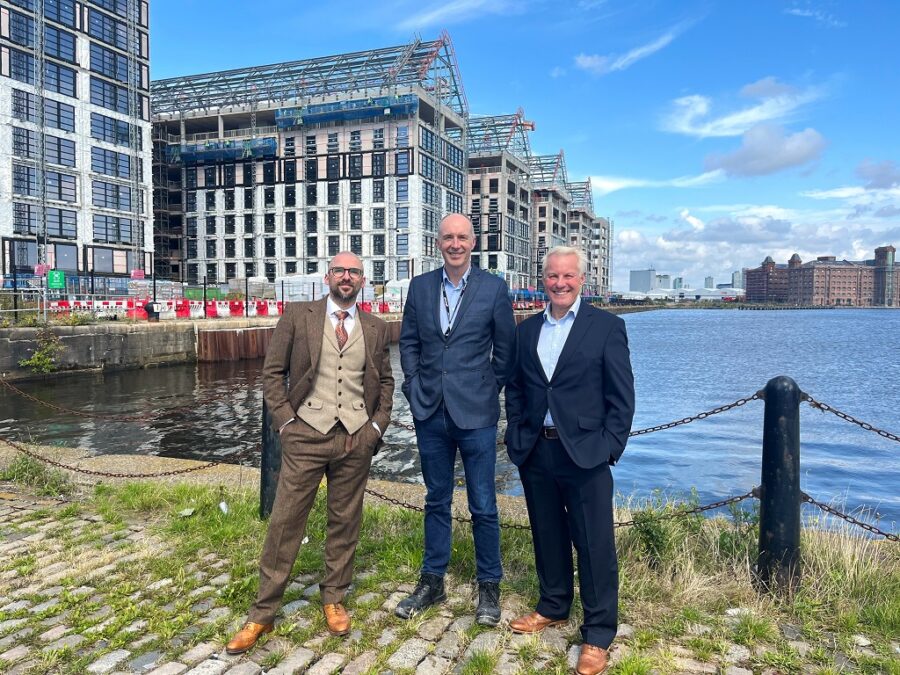Wirral Waters ups its sustainability game
Detailed plans are in for a low-carbon district heat network at the largescale Peel L&P scheme. Meanwhile, the project’s £130m Millers Quay is set to become a hotbed for experiments on how to reduce plastic in construction.
Peel Natural Resources and Energy subsidiary Ener-Vate is leading on the district heat network, which will provide hot water and heat for the thousands of homes and 20m sq ft of mixed-use space planned for the 500-acre former dockland.
The reserved matters application, which has not yet been posted on Wirral Council’s planning portal, includes plans for a low-carbon energy centre and associated pipework.
“Sustainability and low carbon initiatives have always been at the heart of the regeneration of Wirral Waters, and this planning application aims to realise those ambitions through the introduction of a low carbon heating source which will provide connectivity to both existing and future occupiers,” said James Hadfield, strategic waters manager at Ener-Vate.
Funding for the Wirral Waters heat network comes, in part, from the government’s Green Heat Network Fund.
Peel NRE has a similar district heat network across the Mersey in Liverpool. When work on constructing that network and its energy centre is complete, Peel NRE estimates the facility will save 4,200 tonnes of carbon a year.

Changing Stream’s Gareth Abraham, Peel L&P’s Richard Mawdsley, and Changing Stream’s Neal Maxwell have partnered together to reduce plastic waste at Wirral Waters. Credit: If We Ran the Zoo
Peel NRE parent, Peel L&P, is focusing on more than just low-carbon heating solutions. The developer has partnered with advocacy group Changing Streams CIC and the University of Liverpool to explore plastic-free alternatives in construction.
Peel’s 500-home Miller’s Quay is set to become ground zero for this research. Millers Quay topped out last month and will be filled with researchers for the next four months as they analyse ways to reduce the use of plastic.
“Miller’s Quay was designed to be at the forefront of sustainable regeneration and so it is fitting that it should also serve as a pilot for this new partnership,” said Richard Mawdsley, director of development at Wirral Waters.
“Over the last 12 months, the team have already worked together to identify the ‘hidden’ plastics within the specification and detailed design of the building and have established new tools that can help remove them on future projects,” he continued.
“We want to make Wirral Waters one of the most sustainable regeneration projects in the UK, and we cannot achieve this without tackling the issue of plastics in the construction process. Whilst this research is beginning at Miller’s Quay, Changing Streams is likely to be involved in other Wirral Waters developments, such as the Maritime Knowledge Hub.”
If methods of cutting back on plastic can be found, it could go a long way in reducing the country’s waste – currently, Changing Streams estimates that the construction sector is responsible for more than 50,000 tonnes of plastic waste each year in the UK.
“This partnership between Peel L&P, Changing Streams CIC, and the University of Liverpool is the first dedicated attempt to tackle this issue on a large, landmark scheme like Miller’s Quay,” said Gareth Abrahams, co-founder and head of building design research at Changing Streams. “ Our first project together will be an initial step in a long-term plan that will help position the Liverpool City Region as a thought leader and driver of change in the construction industry.”
Changing Streams and the University of Liverpool also partnered with Your Housing Group last year to design and build six prototype houses to see how plastic-free solutions worked in practice.





It would be really great if more construction projects, including this scheme could look at using natural products such as wool! Could the University of Liverpool not come up with more sustainable and viable wool based construction and work wear products? Whilst helping the UK economy – the Times article 27th June 2023 states ‘ sheep farmers burning fleeces because its too expensive to bring them to market’ . There are many other articles on this matter! Farmers are getting below market rate to export the fleeces for the retail industry – it costs them more to shear a sheep than what they will get for the actual fleece. They are sold in bulk to countries such as China – who sell them back to as clothing! Is wool not a more sustainable and environmentally friendly product – especially given that the fleeces are being burned or buried now (wasted).
By Lizzy Baggot
Wool? the mind boggles, what about other surplus products like hair from hairdressers, or toenails and fingernails from nail bars.
By Anonymous
Another half baked idea for forgotten Wirral
Just travel round and see the closed and boarded up shops and buildings
By Geoff Jones
@August 05, 2023 at 10:40 am
By Anonymous
They do use wool in construction you know – as insulation. It’s all natural and sustainable too – we should use it more.
By SW